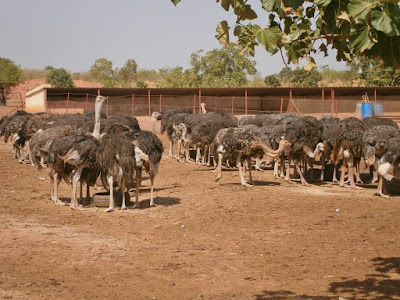I had heard that there is a farm near Bamako with around 3,000 ostriches, and I wanted to see it for myself.
We went to the shop located near the 3rd bridge which sells products from the farm and is called "Les Douceurs de la Ferme." There they gave us a card with phone numbers to call to arrange a visit/tour of the farm. They said that they want people to call to set things up a day in advance, but they were very kind and allowed us to come right away the same day. There was a ticket fee to pay at the shop of 3,000 cfa per person.
We headed east out of Bamako and a few kilometers after passing the Bagineda sign we turned left down a red dirt road. There were no signs when we went, but once we were there we saw that they have a lot of signs ready to be placed, so that will be helpful for future visitors to find their way. The road turned and twisted and we were able to ask a truck going the other way if we were still on the right track. Finally we came to a gate. The gatekeeper wouldn't let us in until his boss talked to him on the phone and gave permission to open the gate, so they have decent security out there.
Our guide was very nice and spent time showing us many things. The farm has about 3,000 ostriches, but it has a lot more than that.
There were a bunch of peacocks to see and hear; they make a lot of crazy noise!
We went to a field with cows, donkeys, and camels hanging out together. Nearby were some very cute calves.
This is our guide in the hat and white shirt. JP is petting a Chadian sheep. It is a very large kind of sheep. There were also some Chadian camels, but we didn't get so close to them. I think JP was proud of being Chadian and having Malians appreciate the fine livestock coming from his country.
It was really hot and sweaty the day of our visit while we were there at midday. The guide said it's better to come really early in the morning or in the late afternoon.
Here I am holding a fresh ostrich egg. They sell these eggs in the shop for around 3.000 cfa (thats like $5) and they also have hollowed out decorated egg shells.

These eggs had been hollowed out and then filled with cement to be permanent decorations on the farm.
Here are some of the many many ostriches. They are fed three times a day when a tractor with workers comes around delivering food. So here they are gathered around to eat.
I learned that male ostriches are black and females are grey/brown.

They aren't very smart, and they are super strong, so they're a bit dangerous.
Here this guy has a number tag, like what you'd see on a cow's ear.
You can also see the picture of some tortoises. There is an enclosed area with lots of these. They go underground where its all dug out and these ones were just peeking out.
They also do bee-keeping and have a honey production house. The guide wanted to show us the honey stuff but he didn't have the key to that building. So that's something to look forward to next time.
The farm is huge and has so many buildings. And they are going to be even greater. While we were there we saw a big Caterpillar backhoe and a bulldozer at work. They were digging a hole for a swimming pool!



























